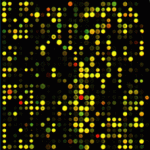Genomics
|
8 may 2012 13:52:26 |
| Phylogenomic analysis of UDP glycosyltransferase 1 multigene family in Linum usitatissimum identified genes with varied expression patterns (BMC Genomics) |
|
Tweet Background:
The glycosylation process, catalyzed by ubiquitous glycosyltransferase (GT) family enzymes, is a prevalent modification of plant secondary metabolites that regulates various functions such as hormone homeostasis, detoxification of xenobiotics and biosynthesis and storage of secondary metabolites. Flax (Linum usitatissimum L.) is a commercially grown oilseed crop, important because of its essential fatty acids and health promoting lignans. Identification and characterization of UDP glycosyltransferase (UGT) genes from flax could provide valuable basic information about this important gene family and help to explain the seed specific glycosylated metabolite accumulation and other processes in plants. Plant genome sequencing projects are useful to discover complexity within this gene family and also pave way for the development of functional genomics approaches.
Results:
Taking advantage of the newly assembled draft genome sequence of flax, we identified 137 UDP glycosyltransferase (UGT) genes from flax using a conserved signature motif. Phylogenetic analysis of these protein sequences clustered them into 14 major groups (A-N). Expression patterns of these genes were investigated using publicly available expressed sequence tag (EST), microarray data and reverse transcription quantitative real time PCR (RT-qPCR). Seventy-three per cent of these genes (100 out of 137) showed expression evidence in 15 tissues examined and indicated varied expression profiles. The RT-qPCR results of 10 selected genes were also coherent with the digital expression analysis. Interestingly, five duplicated UGT genes were identified, which showed differential expression in various tissues. Of the seven intron loss/gain positions detected, two intron positions were conserved among most of the UGTs, although a clear relationship about the evolution of these genes could not be established. Comparison of the flax UGTs with orthologs from four other sequenced dicot genomes indicated that seven UGTs were flax diverged.
Conclusions:
Flax has a large number of UGT genes including few flax diverged ones. Phylogenetic analysis and expression profiles of these genes identified tissue and condition specific repertoire of UGT genes from this crop. This study would facilitate precise selection of candidate genes and their further characterization of substrate specificities and in planta functions. |
| 251 viewsCategory: Genomics |
 The footprint of metabolism in the organization of mammalian genomes (BMC Genomics) The footprint of metabolism in the organization of mammalian genomes (BMC Genomics)Construction of physical maps for the sex-specific regions of papaya sex chromosomes (BMC Genomics) 
|
| blog comments powered by Disqus |
MyJournals.org
The latest issues of all your favorite science journals on one page
The latest issues of all your favorite science journals on one page



